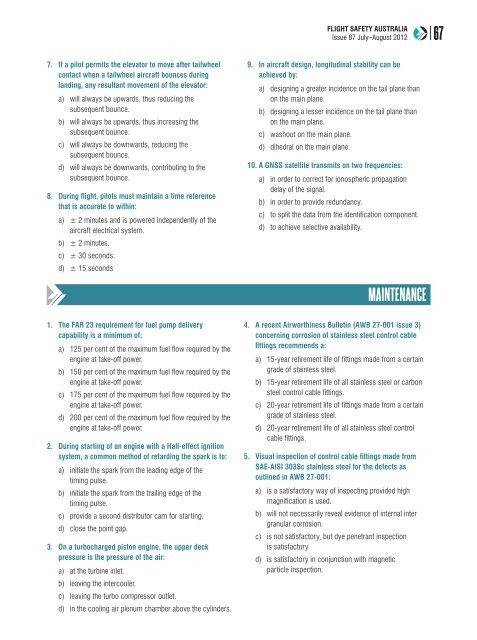jul-aug2012
Create successful ePaper yourself
Turn your PDF publications into a flip-book with our unique Google optimized e-Paper software.
Flight Safety Australia<br />
Issue 87 July–August 2012<br />
67<br />
7. If a pilot permits the elevator to move after tailwheel<br />
contact when a tailwheel aircraft bounces during<br />
landing, any resultant movement of the elevator:<br />
a) will always be upwards, thus reducing the<br />
subsequent bounce.<br />
b) will always be upwards, thus increasing the<br />
subsequent bounce.<br />
c) will always be downwards, reducing the<br />
subsequent bounce.<br />
d) will always be downwards, contributing to the<br />
subsequent bounce.<br />
8. During flight, pilots must maintain a time reference<br />
that is accurate to within:<br />
a) ± 2 minutes and is powered independently of the<br />
aircraft electrical system.<br />
b) ± 2 minutes.<br />
c) ± 30 seconds.<br />
d) ± 15 seconds<br />
9. In aircraft design, longitudinal stability can be<br />
achieved by:<br />
a) designing a greater incidence on the tail plane than<br />
on the main plane.<br />
b) designing a lesser incidence on the tail plane than<br />
on the main plane.<br />
c) washout on the main plane.<br />
d) dihedral on the main plane.<br />
10. A GNSS satellite transmits on two frequencies:<br />
a) in order to correct for ionospheric propagation<br />
delay of the signal.<br />
b) in order to provide redundancy.<br />
c) to split the data from the identification component.<br />
d) to achieve selective availability.<br />
MAINTENANCE<br />
1. The FAR 23 requirement for fuel pump delivery<br />
capability is a minimum of:<br />
a) 125 per cent of the maximum fuel flow required by the<br />
engine at take-off power.<br />
b) 150 per cent of the maximum fuel flow required by the<br />
engine at take-off power.<br />
c) 175 per cent of the maximum fuel flow required by the<br />
engine at take-off power.<br />
d) 200 per cent of the maximum fuel flow required by the<br />
engine at take-off power.<br />
2. During starting of an engine with a Hall-effect ignition<br />
system, a common method of retarding the spark is to:<br />
a) initiate the spark from the leading edge of the<br />
timing pulse.<br />
b) initiate the spark from the trailing edge of the<br />
timing pulse.<br />
c) provide a second distributor cam for starting.<br />
d) close the point gap.<br />
3. On a turbocharged piston engine, the upper deck<br />
pressure is the pressure of the air:<br />
a) at the turbine inlet.<br />
b) leaving the intercooler.<br />
c) leaving the turbo compressor outlet.<br />
d) in the cooling air plenum chamber above the cylinders.<br />
4. A recent Airworthiness Bulletin (AWB 27-001 issue 3)<br />
concerning corrosion of stainless steel control cable<br />
fittings recommends a:<br />
a) 15-year retirement life of fittings made from a certain<br />
grade of stainless steel.<br />
b) 15-year retirement life of all stainless steel or carbon<br />
steel control cable fittings.<br />
c) 20-year retirement life of fittings made from a certain<br />
grade of stainless steel.<br />
d) 20-year retirement life of all stainless steel control<br />
cable fittings.<br />
5. Visual inspection of control cable fittings made from<br />
SAE-AISI 303Sc stainless steel for the defects as<br />
outlined in AWB 27-001:<br />
a) is a satisfactory way of inspecting provided high<br />
magnification is used.<br />
b) will not necessarily reveal evidence of internal inter<br />
granular corrosion.<br />
c) is not satisfactory, but dye penetrant inspection<br />
is satisfactory.<br />
d) is satisfactory in conjunction with magnetic<br />
particle inspection.

















